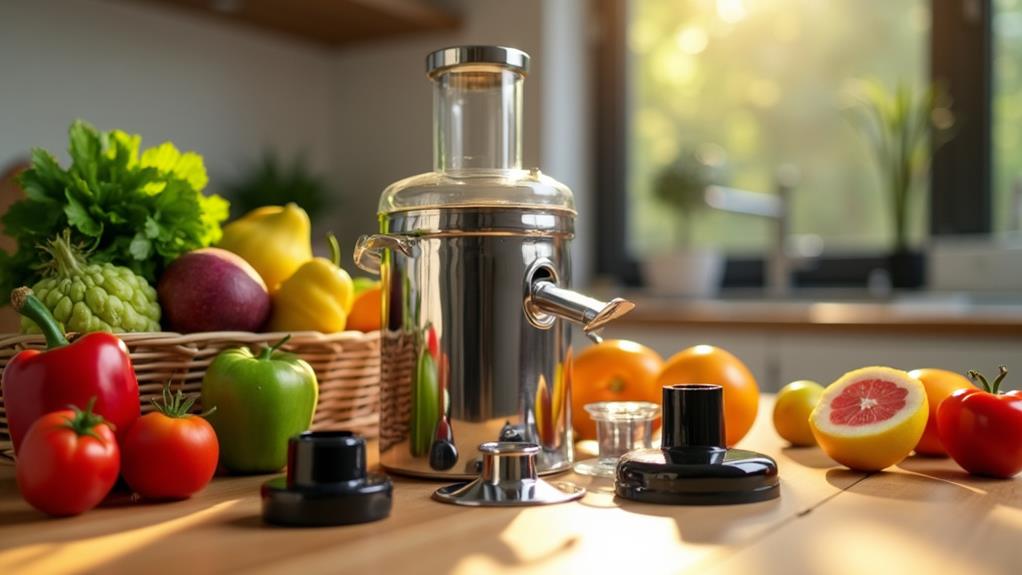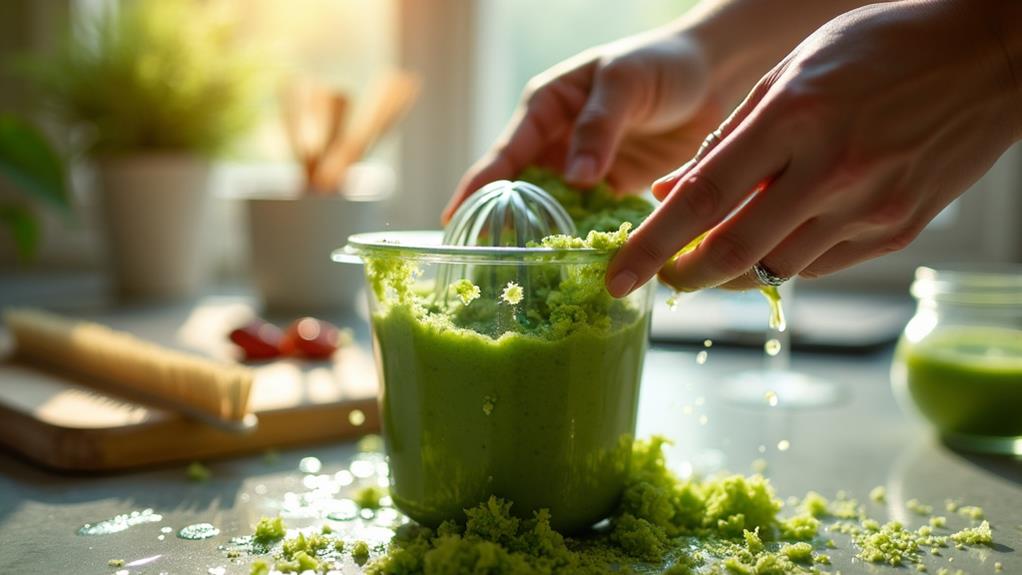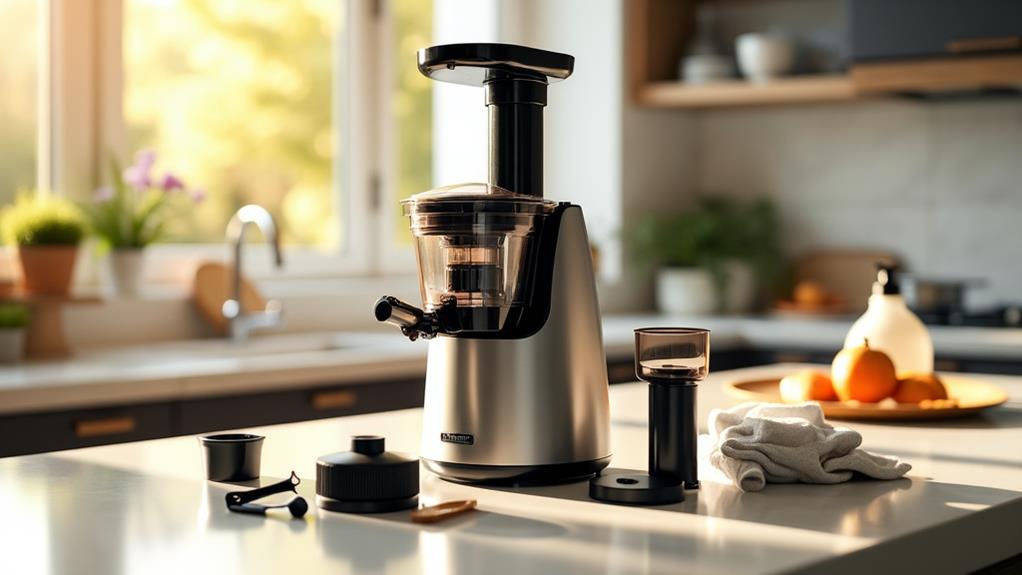Essential Juicer Maintenance Tips

To keep your juicer in top shape, start by disassembling and rinsing all parts right after use. Use a soft sponge for larger components and a cleaning brush for smaller ones. For stubborn pulp, soak parts in warm, soapy water and tackle build-up with a baking soda paste. Don't forget to air-dry all pieces to prevent mold. Regularly check for wear and tear, ensuring blades stay sharp and moving parts are lubricated as per the manufacturer's advice. Finally, check for unusual noises and electrical connections to catch issues early. Immerse yourself in these tips to maintain a perfect juicing experience.
Understanding Your Juicer
Getting to know your juicer is essential for making the most out of your juicing experience. Understanding the different juicer parts and their functions can greatly improve how you prepare fruits and vegetables. Masticating juicers, for instance, work by crushing and pressing produce slowly, preserving more nutrients. This efficiency means you need to regularly check the components for pulp residue, which can accumulate and affect performance.
Juicer maintenance is not just about keeping your appliance clean; it's about ensuring it runs smoothly and lasts longer. Taking time to familiarize yourself with how each part fits and works can help you troubleshoot common issues, like clogging from fibrous produce. Disassembling the juicer for regular cleaning prevents build-up that can lead to malfunctions. It's also an opportunity to inspect for wear and tear, so you can replace any damaged parts before they cause bigger problems.
Cleaning Routine Essentials
Maintaining a clean juicer is vital for both performance and hygiene. To clean your juicer effectively, start by disassembling and rinsing all components immediately after use. This prevents dried pulp and residue from building up, which can impact performance. Use a cleaning brush for small parts and a soft sponge for larger components to guarantee a thorough cleaning without causing any damage.
Keep an eye on the screen or filter, as these areas tend to collect pulp. Soak these parts in warm, soapy water if you notice any stubborn residue. A nylon brush can help you remove clogs effectively without harming the delicate surfaces.
After washing, it's important to air-dry all parts completely. Proper drying prevents mold growth and guarantees your juicer maintains its functionality over time. Don't forget to regularly inspect and clean the base of your juicer. Use a damp cloth and mild detergent to wipe away any food particles or stains from juicing ingredients.
These cleaning routine necessities will help you maintain a clean, efficient juicer. By following these steps, you're making sure your appliance remains in top condition for many delicious and healthy juicing sessions.
Tackling Stubborn Pulp

When dealing with stubborn pulp in your juicer, a proactive approach is your best ally. Begin by dismantling the juicer parts immediately after use. This prevents pulp from drying and becoming more challenging to remove. Soak these parts in warm, soapy water for 15-30 minutes to loosen any residue. This simple step makes tackling stubborn pulp much easier.
For components that still have persistent pulp build-up, create a paste using baking soda and water. This gentle, yet effective solution won't damage your juicer parts while it works to lift remaining debris. Apply the paste to the affected areas, allowing it to sit for a few minutes before rinsing.
In conjunction with these methods, using a cleaning brush specifically designed for juicer parts can help you reach and remove pulp lodged in those hard-to-reach spots. This guarantees a thorough clean, maintaining your juicer's efficiency and hygiene.
Common Juicer Issues
Juicers, like any kitchen appliance, can occasionally run into a few common issues that may disrupt their performance. One frequent problem is clogging, often caused by juicing fibrous fruits and vegetables. These fibrous materials can obstruct screens and reduce efficiency, so it's vital to scrub the screen thoroughly after each use. This helps prevent blockages and guarantees smooth operation.
Another issue you might encounter is unpleasant odors or discoloration. Fortunately, you can tackle both with a baking soda solution. Simply mix baking soda with water to create a paste and apply it to the affected areas. It acts as a natural cleaner, freshening up your juicer and removing stains.
If your juicer fails to start, you might be facing an electrical issue. Check the power cord and connections for any damage. Sometimes, a loose plug or a frayed wire can be the culprit. Likewise, unusual sounds or vibrations during operation could signal mechanical problems. Address these promptly to avoid further damage.
Regularly checking for these common issues, like blade sharpness and pulp buildup, will help you keep your juicer in top condition and improve its performance and longevity.
Regular Maintenance Tasks

Your juicer's longevity and performance hinge on regular maintenance tasks that keep it running smoothly. To guarantee your juicer stays in top condition, pay attention to the diverse parts that need care. Start by cleaning all juicing components immediately after every use. This simple step prevents residue buildup, which can negatively affect both performance and hygiene. Don't forget to regularly check and empty the pulp container; this guarantees peak juicing efficiency and prevents blockages.
Next time you use your juicer, inspect the blades for sharpness and wear. Keeping the blades in good condition is vital for effective juicing and prolonging the life of your machine. Moreover, lubricate moving parts according to the manufacturer's guidelines. This will guarantee smooth operation and help prevent mechanical issues down the road.
Incorporate these regular maintenance tasks into your routine:
- Clean daily: Rinse juicing components immediately after use to avoid residue buildup.
- Blade check: Inspect for sharpness and wear to maintain efficiency.
- Weekly deep clean: Wash all removable parts with warm, soapy water to keep them pristine.




